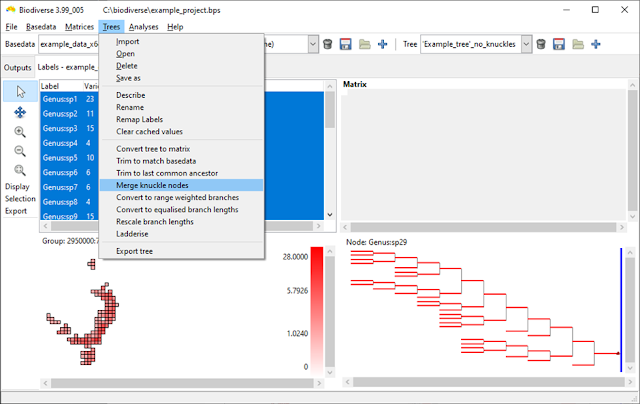2021 is now in full swing, so here is a list of publications from 2019 that used Biodiverse.
If you want to see the full list (155 at the time of writing), then go to
https://github.com/shawnlaffan/biodiverse/wiki/PublicationsList For more details about Biodiverse, see
http://shawnlaffan.github.io/biodiverse/ Shawn Laffan
12-Mar-2022
Anguiano-Constante, M.A., Dean, E., Starbuck, T., Rodríguez, A. And Munguía-Lino, G. (2021) Diversity, species richness distribution and centers of endemism of Lycianthes (Capsiceae, Solanaceae) in Mexico.
Phytotaxa, 514, 39-60.
Bharti, D.K., Edgecombe, G.D., Karanth, K.P. and Joshi, J. (2021) Spatial patterns of phylogenetic diversity and endemism in the Western Ghats, India: A case study using ancient predatory arthropods.
Ecology and Evolution, 11, 16499-16513.
Camacho, G.P., Loss, A.C., Fisher, B.L., Blaimer, B.B. (2021) Spatial phylogenomics of acrobat ants in Madagascar—Mountains function as cradles for recent diversity and endemism.
Journal of Biogeography, 48, 1706-1719.
Cheikh Albassatneh, M., Escudero, M., Monnet, A‐C., et al. (2021) Spatial patterns of genus‐level phylogenetic endemism in the tree flora of Mediterranean Europe.
Diversity and Distributions, 27, 913– 928.
Earl, C., Belitz, M.W., Laffan, S.W., Barve, V., Barve, N., Soltis, D.E., Allen, J.M., Soltis, P.S., Mishler, B.D., Kawahara, A.Y., & Guralnick, R. (2021) Spatial phylogenetics of butterflies in relation to environmental drivers and angiosperm diversity across North America.
iScience, 102239.
Flores-Tolentino M., Beltrán-Rodríguez L., Morales-Linares J., et al. (2021) Biogeographic regionalization by spatial and environmental components: Numerical proposal.
PLoS ONE 16, e0253152.
Furtado, S.G. and Menini Neto, L. (2021) What is the role of topographic heterogeneity and climate on the distribution and conservation of vascular epiphytes in the Brazilian Atlantic Forest?
Biodiversity and Conservation, 30, 1415–1431.
Garcia-Rodriguez, A., Luna-Vega, I., Yáñez-Ordóñez, O., Ramírez-Martínez, J.C., Espinosa, D., and Contreras-Medina, R. (2021). Patrones de Distribución de las Abejas del Bosque Mesófilo de Montaña de la Sierra Madre Oriental, México.
Southwestern Entomologist, 46, 1021-1036.
González-Orozco, C.E. (2021) Biogeographical regionalisation of Colombia: a revised area taxonomy.
Phytotaxa, 484, 3.
González-Orozco, C.E. (2021) Regiones biogeográficas del género Cinchona L. (Rubiaceae- Cinchoneae).
Revista Novedades Colombianas, 16, 135-156.
González-Orozco, C. E., Sosa, C. C., Thornhill, A. H., and Laffan, S. W. (2021). Phylogenetic diversity and conservation of crop wild relatives in Colombia.
Evolutionary Applications, 14, 2603-2617.
Gosper, C.R., Coates, D.J., Hopper, S.D., Byrne, M., Yates, C.J. (2021) The role of landscape history in the distribution and conservation of threatened flora in the Southwest Australian Floristic Region.
Biological Journal of the Linnean Society, 133, 394–410.
Hammer, T.A., Renton, M., Mucina, L. and Thiele, K. (2021) Arid Australia as a source of plant diversity: the origin and climatic evolution of Ptilotus (Amaranthaceae).
Australian Systematic Botany, 34, 570-586.
Hao, T., Elith, J., Guillera-Arroita, G., Lahoz-Monfort, J. J., & May, T. W. (2021). Enhancing repository fungal data for biogeographic analyses.
Fungal Ecology, 53, 101097.
Kougioumoutzis, K., Kokkoris, I.P., Panitsa, M., Kallimanis, A., Strid, A., and Dimopoulos, P. (2021) Plant Endemism Centres and Biodiversity Hotspots in Greece.
Biology, 10, 72.
Murali, G., Gumbs, R., Meiri, S. and Rull, U. (2021) Global determinants and conservation of evolutionary and geographic rarity in land vertebrates.
Science Advances, 7, eabe5582.
Ortiz-Brunel, J.P., Munguía-Lino, G., Castro-Castro, A. and Rodríguez, A. (2021) Biogeographic analysis of the American genus Echeandia (Agavoideae: Asparagaceae).
Revista Mexicana de Biodiversidad 92, e923739.
Paz, A., Brown, J.L., Cordeiro, C.L.O., Aguirre‐Santoro, J., Assis, C., Amaro, R.C., Raposo do Amaral, F., Bochorny, T., Bacci, L.F., Caddah, M.K., d’Horta, F., Kaehler, M., Lyra, M., Grohmann, C.H., Reginato, M., Silva‐Brandão, K.L., Freitas, A.V.L., Goldenberg, R., Lohmann, L.G., Michelangeli, F.A., Miyaki, C., Rodrigues, M.T., Silva, T.S. and Carnaval, A.C. (2021) Environmental correlates of taxonomic and phylogenetic diversity in the Atlantic Forest.
Journal of Biogeography, 48, 1377-1391.
Pereira, L.C., Chautems, A. and Menini Neto, L. (2021) Biogeography and Conservation of Gesneriaceae in the Serra da Mantiqueira, Southeastern Region of Brazil.
Brazilian Journal of Botany, 44, 239–248.
Pinedo-Escatel, J.A., Aragón-Parada, J., Dietrich, C.H., Moya-Raygoza, G., Zahniser, J.N. and Portillo, L. (2021) Biogeographical evaluation and conservation assessment of arboreal leafhoppers in the Mexican Transition Zone biodiversity hotspot.
Diversity and Distributions, 27, 1051-1065.
Suissa, J.S., Sundue, M.A. and Testo, W.L. (2021), Mountains, climate and niche heterogeneity explain global patterns of fern diversity.
Journal of Biogeography, 48, 1296-1308.
Yang, X., Liu, B., Bussman, R.W., Guan, X., et al. (2021) Integrated plant diversity hotspots and long-term stable conservation strategies in the unique karst area of southern China under global climate change.
Forest Ecology and Management, 498, 119540.
Xu, M.‐Z., Yang, L.‐H., Kong, H.‐H., Wen, F. and Kang, M. (2021) Congruent spatial patterns of species richness and phylogenetic diversity in karst flora: the case study of Primulina (Gesnariaceae).
Journal of Systematics and Evolution, 59, 251-261.
Xue, T., Gadagkar, S.H., Albright, T.P., Yang, X., Li, J., Xia, C., Wu, J., and Yu, S. (2021) Prioritizing conservation of biodiversity in an alpine region: Distribution pattern and conservation status of seed plants in the Qinghai-Tibetan Plateau.
Global Ecology and Conservation, 32, e01885.
Zhang, Y., Chen, J. and Sun, H. (2021) Alpine speciation and morphological innovations: revelations from a species-rich genus in the Northern Hemisphere.
AoB PLANTS, 13, 3, plab018.
Zhang, Y., Qian, L., Spalink, D., Sun, L., Chen, J. and Sun, H. (2021) Spatial phylogenetics of two topographic extremes of the Hengduan Mountains in southwestern China and its implications for biodiversity conservation.
Plant Diversity, 43, 181-191.
Zhu, Z-X, Harris, A.J., Nizamani, M.M., Thornhill, A.H., Scherson, R.A. and Wang, H-F. (2021) Spatial phylogenetics of the native woody plant species in Hainan, China.
Ecology and Evolution, 11, 2100-2109.
































